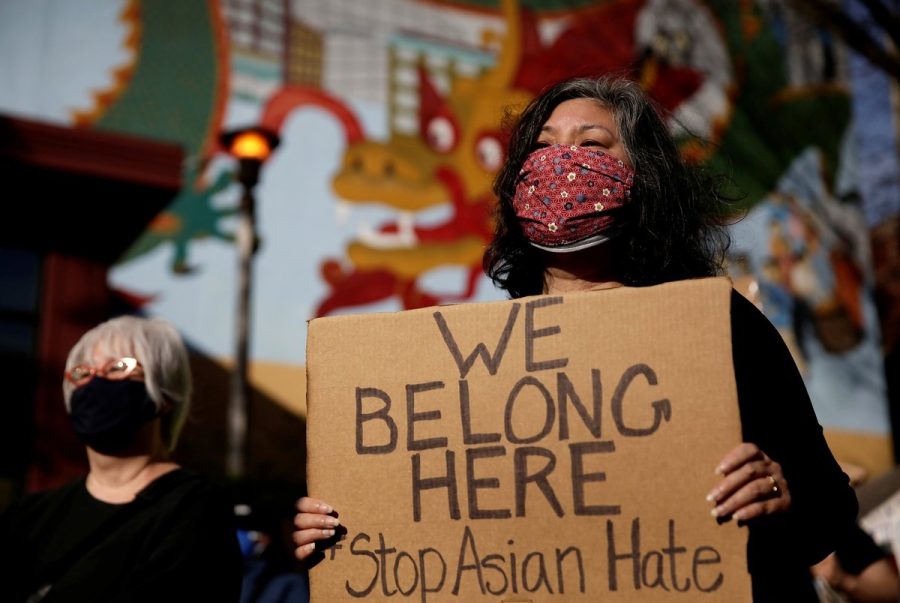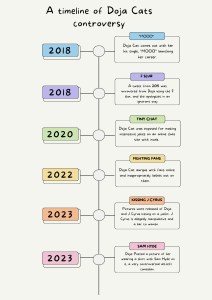Addressing AAPI racism and hate
April 14, 2021
Xiaojie Tan arrived at work on March 16th, at one of the two spas she owned. Her 50th birthday was coming up in a few days, and she planned on celebrating it with her daughter, Jami Webb. Tan was planning on retiring soon.
Tan was shot and killed that day in a mass shooting in Atlanta, Georgia. Webb told CNN in an interview, “I just want to hold her tight…give her a hug…hold her hand, hug her for a long time.”
The Atlanta spa shooting that claimed the lives of eight people, six of whom were Asian-American women, is a gruesome highlight of the rise in violence and hate targeted at the AAPI community.
Hate Crime Statistics
While anti-Asian racism is not new at all, there has been a significant increase in violent crimes against the AAPI community. According to a study done by the Center for the Study of Hate and Extremism at California State, hate crimes against Asian Americans increased between 2019-2020 by 149%, from 49 to 122.
Stop AAPI Hate, a separate organization dedicated to fighting anti-Asian racism, cataloged nearly 3,800 racist incidents (around 11% reported were violent) during the first year of the pandemic.
This drastic increase in hate crimes against Asian Americans is made worse by the fact that hate crimes overall fell by 7% because of various shutdowns, according to the Center’s study.
However, these numbers may not be entirely accurate. They could be much higher. Jeanine Bell, and Indiana University law professor and hate crime expert, told the Poynter Institute-operated news project Politifact, “There are barriers to reporting. Individual victims have to feel as if they are comfortable enough to report, and most likely they don’t.”
Hate crimes against Asian Americans are especially underreported for a variety of reasons, including language or cultural barriers, distrust of police, or fear of repercussions for their immigration status if they aren’t citizens.
Dangerous Rhetoric and Stereotypes
This increase in hate stems from the rise in ignorant language and rhetoric that blames the spread of Covid-19 on China. Calling coronavirus the “China Virus” or “Kung-Flu” is a prime example of this. Google searches for those two racist terms shot up drastically through 2020 according to the Center’s study, after they were popularized by then-president Donald Trump.
On March 23, 2020, Trump refrained from using anti-Asian language. The director of the Center for the Study of Hate and Extremism says to Politico, “…when President Trump refrained from ethnic terms relating to the virus for a day and spoke of tolerance, there were no anti-Asian hate crimes in NYC in what otherwise was a historically bad month for hate crime.”
Stereotypes also play a large role in racist attacks against the AAPI community. Orientalism is one of the first forms of stereotypes that belittles the Asian community. Orientalism represents a Western European view of eastern countries and regions like the Middle East, North Africa, and Eastern Asia that oversexualizes cultures (for example, Geishas portrayed in Western media) and paints the people of these regions as crude and in need of Western subjugation.
Examples and explanations of Orientalism in popular culture include:
Disney’s Aladdin (1992 and 2019)
Lil Dicky’s Freaky Friday music video (2018)
Marvel’s Doctor Strange (2016)
Miss Saigon (1989-2019)
Breakfast at Tiffany’s (1961)
Memoirs of a Geisha (2005)
Another equally harmful and important stereotype is the “model minority” myth. Andrew Sullivan, a journalist for the New York Magazine, writes:
“Today, Asian-Americans are among the most prosperous, well-educated, and successful ethnic groups in America. What gives? It couldn’t possibly be that they maintained solid two-parent family structures, had social networks that looked after one another, placed enormous emphasis on education and hard work, and thereby turned false, negative stereotypes into true, positive ones, could it? It couldn’t be that all whites are not racists or that the American dream still lives?”
This quote sums up the whole “model minority” idea about Asian Americans and how it makes gross generalizations about AAPI people, despite recent poverty data. The “model minority” myth ignores the racism faced by the AAPI community, and allows a segment of white America to be complacent with racism and not take responsibility for racist words or actions.
Additionally, the “model minority” myth equates Asian success with the failure of other racial minorities, especially black people. By saying AAPI people “placed enormous emphasis on education and hard work,” it is implied that a) other racial minorites do not do this and b) any racial minority, no matter the severity of the discrimination and maltreatment in America or otherwise, should be able to thrive. This NPR article and this more recent Times article goes more in depth for further reading about the problems with the “model minority” myth.
Examples of the “model minority” myth in popular culture include:
- Data in The Goonies (1985)
- Takashi Toshiro in Revenge of the Nerds (1984)
- Conrad Ricamora in How to Get Away with Murder (2014-2020)
- Mrs. Kim in Gilmore Girls (2000-2007)
Looking forward
A diverse coalition of nonprofit organizations, universities, and businesses are striving to combat anti-Asian racism. Stop AAPI Hate, the previously mentioned nonprofit, recommends encouraging anyone you know who has experienced anti-Asian racism to report it on their website, linked here. They also recommend sharing safety tips with AAPI people you know, being informed on what’s happening and why, and donating money to them or the Movement Hub, a platform that brings together several nonprofits working against anti-Asian racism.
Several universities nationwide have put statements on their various websites standing with the Asian community, including The Ohio State University. The Kirwan Institute for the Study of Race and Ethnicity gave this statement, which includes several resources for helping the AAPI community.
As of April 1st, nearly 1,000 Asian-American business executives and leaders have pledged to donate $10 million to organizations fighting against anti-Asian racism. Among these business leaders are Zoom CEO Eric Yuan, and YouTube co-founder Steve Chen.
People as a whole also have many things they can do to help combat anti-Asian racism. In a recent Rolling Stones interview, John Yang, president and executive director of Asian Americans Advancing Justice-AAJC, gave four main things a person can do to help the AAPI community right now:
- Provide Community Resources
Yang says it is important to create safety networks for elderly Asian people, as well as provide community resources in the result of an attack and creating a community response team that helps to provide those community resources.
- Inter-Community and Inter-Racial Dialogue
Yang stresses the importance of dialogue between Asian communities and non-Asian communities. “Because the bottom line is, we’re all in this together. And if we all feel that connective thread, that connective tissue, that’s what’s going to lead to longer-term solutions, longer-term protection of all of us during this environment,” Yang says.
- Educate Yourself
Understanding the xenophobia-plagued history of Asian Americans is a fundamental part of combating racism. It also helps people realize how long Asian Americans have been a part of the United States and the roles they have played in history.
- Donate
Making donations to anti-racist organizations like Yang’s Asian Americans Advancing Justice-AAJC is a prime way to help Asian American communities. These donations are also tax deductible.
Additionally, Asian Americans Advancing Justice-AAJC partnered with the organization Hollback! to create a bystander intervention guide that provides tips on how to help stop racist incidents. The Rolling Stones article also provides a comprehensive list of more things that can be done to combat anti-Asian racism. The Stones recommends:
Volunteering in your Community to create a safety net program that checks on Asian-owned businesses and community members.
Reporting Racist Incidents to Stop AAPI Hate or Stand Against Hatred.
Engaging with Asian American art by listening to Asian American music, reading Asian American literature and poetry, or taking a virtual tour of the Wing Luke Museum in Seattle.
Checking in on someone you know. The AAPI community makes up about six or seven percent of America’s population, so chances are you know someone who is of Asian descent. Make sure they’re doing good in these turbulent times, and help them any way you can.
Becoming anti-racist is not an easy task. As a white person, it can be uncomfortable to learn things I perceived as harmless are actually a little racist. The orientalism of Doctor Strange surprised me especially; I never thought a recent Marvel movie could be problematic in any way.
It’s perfectly fine to have to think about these things for a day or more, and it’s perfectly fine to take a break when you need to. Racism is a heavy topic. But you can not stop advocating for Asian Americans–or any racial minority– in important times like these. Be anti-racist whenever you can.









